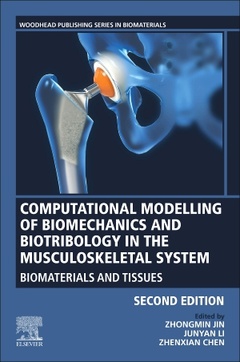Computational Modelling of Biomechanics and Biotribology in the Musculoskeletal System (2nd Ed.) Biomaterials and Tissues Woodhead Publishing Series in Biomaterials Series
Coordonnateurs : Jin Z, Li Junyan, Chen Zhenxian

Computational Modelling of Biomechanics and Biotribology in the Musculoskeletal System: Biomaterials and Tissues, Second Edition reviews how a wide range of materials are modeled and applied. Chapters cover basic concepts for modeling of biomechanics and biotribology, the fundamentals of computational modeling of biomechanics in the musculoskeletal system, finite element modeling in the musculoskeletal system, computational modeling from a cells and tissues perspective, and computational modeling of the biomechanics and biotribology interactions, looking at complex joint structures. This book is a comprehensive resource for professionals in the biomedical market, materials scientists and biomechanical engineers, and academics in related fields.
This important new edition provides an up-to-date overview of the most recent research and developments involving hydroxyapatite as a key material in medicine and its application, including new content on novel technologies, biomorphic hydroxyapatite and more.
Part I: Generic Modelling of Biomechanics and Biotribology 1. Basic Concepts 2. Fundamentals of Computational Modelling of Biomechanics in the Musculoskeletal System 3. Explicit Finite Element Modelling of Artificial Hip and Knee Joints 4. Introduction to Musculoskeletal Modelling 5. Finite Element Modelling Framework for Biomechanics and Biotribology in the Musculoskeletal System 6. Coupling of Musculoskeletal Biomechanics and Joint Biotribology
Part II: Computational Modelling of Musculoskeletal Cells, Tissues, and Biomaterials 7. Multiscale Modelling of Soft Tissue Mechanics: Application to Tendons and Ligaments 8. Modelling of Muscle, Tendon and Ligament Biomechanics 9. Modelling of Articular Cartilage 10. Modelling of Bone and Bone Remodelling 11. Modelling of Bone Microstructure 12. Geometry Optimization of Scaffolds for Bone Tissue Engineering
Part III: Computational Modelling of Orthopaedic Systems and Interfaces 13. Three-Dimensional Model for Assessing the Pore Volume of Biomaterial Intended for Implantation 14. Biomechanical Studies of Human Diaphyseal Tibia Fracture Fixation 15. Modelling of Cementless Cup Fixation in Total Hip Arthroplasty 16. Modelling of Lubrication in Hip Joint Implants 17. Modelling of Knee Joints
Part IV: Computational Modelling of Biomechanics and Biotribology Interactions 18. Modelling of Biomechanics and Biotribology for Artificial Shoulder Joints 19. Modelling of Biomechanics and Biotribology for Artificial Ankle Joints 20. Modelling of Biomechanics and Biotribology for Artificial Hip Joints 21. Modelling of Biomechanics and Biotribology for Artificial Knee Joints 22. Modelling of Biomechanics and Biotribology for the Spine
Materials scientists and engineers in academia and R&D, with a focus in biomaterials development and application; tissue engineering and computational modelling
Dr Junyan Li is a Senior Lecturer at Middlesex University, UK. Dr. Li’s current research interests are the study of bone, joint and muscle mechanisms, and the evaluation of treatment outcomes for musculoskeletal conditions. In particular, he is developing new modelling technologies and platforms to couple biomechanics and biotribology in the musculoskeletal system.
Zhenxian Chen is Senior Engineer of Mechanical Engineering, Chang’an University. He is mainly engaged in implant bionic design, and the biotribology and biomechanics of artificial joints in the musculoskeletal system.
- Provides detailed, introductory coverage of modeling of cells and tissues, modeling of biomaterials and interfaces, biomechanics and biotribology
- Discusses applications of modeling for joint replacements and applications of computational modeling in tissue engineering
- Offers a holistic perspective, from cells and small ligaments to complex joint interactions
Date de parution : 09-2020
Ouvrage de 632 p.
15x22.8 cm
Thèmes de Computational Modelling of Biomechanics and Biotribology... :
Mots-clés :
3D muscle modelling; Aponeurosis; Articular cartilage mechanics; Artificial hip joint; Artificial knee joint; Artificial shoulder joint; Basic concepts; Beam-based scaffold; Biomechanics; Biotribology; Biphasic model; Bone microstructure; Bone substitute; Collagen fibers; Computational model; Computational modelling; Computational multiscale models; Concurrent modelling; Contact mechanics; Contact mechanism; Coupled simulation; Crushable foam; CT imaging; Diaphyseal; EHL; Explicit finite element method; Fibril-reinforced model; Finite element; Finite element analysis; Finite element method; Finite element model; Finite element modelling; Finite element wear model; Fixation; Force depression; Force enhancement; Force-dependent kinematics; Fracture; Functional adaptation; Gait cycle; Hill-type; Hip joint; Inverse dynamics; Irregular scaffold; Joint; Kinematics; Kinetics; Knee dynamics; Knee joint modelling; Knee kinematics; Ligament; Lubrication; Material model; Mechanical property; Mechanics of soft tissues; Mechanobiology; Mechanoregulation algorithm; Modelling; Multibody dynamic analysis; Multibody dynamics; Multiscale modelling; Muscle; Muscle architecture; Muscle mechanics; Muscle recruitment; Musculoskeletal; Musculoskeletal model; Musculoskeletal modelling; Musculoskeletal multibody dynamics; Musculoskeletal system; Nonspherical; Numerical modelling; Numerical simulation; Orthopedic; Polycarbonate polyurethane (PCU); Pore model; Pore volume; Poromechanical behavior; Porosity of biomaterial; Press-fit cup fixation; Primary stability; Recruitable elastic spring; Regular scaffold; Spine biomechanics; Strain-rate dependence; Strength; Surface texturing; Synovial fluid; Tendon; Tendons and ligaments; Theory; Tibia; Tissue defects; Titin; Total ankle arthroplasty; Trabecular bone; Traction-torsion loading; Ultrahigh molecular weight polyethylene (UHMWPE); Validation; Verification; Viscoelasticity; Wear; Wear prediction



